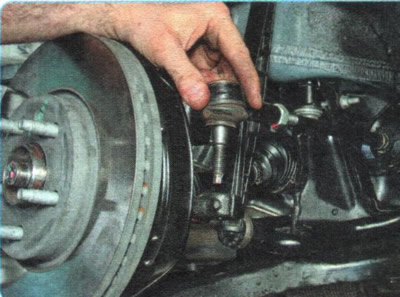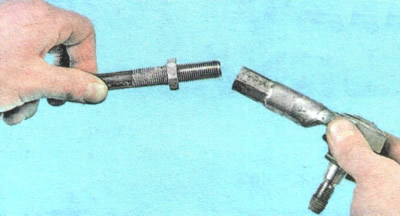NOTES: It is more convenient to perform work on a lift. You can also perform it on a car mounted on supports. Replacement of a tip is shown on an example of the left steering draft, replace the right tip similarly. The thread of the left tip is right-handed, and the right tip is left-handed.
1. Raise and support the front of the vehicle on the side of the tip to be replaced. Remove the wheel.
WARNING: Park the vehicle and place wheel chocks under the rear wheels («shoes»).
TIP: If fasteners are heavily soiled, clean them with a wire brush and treat with a light penetrating lubricant (e.g. WD-40).

2. Measure and write down the length A of the free part of the tie rod thread, so that when assembling, if possible, do not violate the toe angles of the wheels.

3. While holding the tie rod with a wrench, loosen the tie rod end lock nut.

4. While holding the ball joint pin from turning, loosen the nut securing the tip ball pin to the steering knuckle arm.

5. Completely unscrew the nut.

6. Install the ball joint puller, press the pin out of the steering knuckle boss...
USEFUL ADVICE: In the absence of a puller, the ball joint pin can be knocked out with sharp hammer blows on the end face of the steering knuckle boss, striking along the lever axis.

7.... and remove the finger from the steering knuckle.

8. Unscrew the tip from the steering rod, counting the number of revolutions, so that when installing a new tip, if possible, the toe-in does not change.
NOTE: Shown with tie rod removed for clarity.

9. Turn away a counternut.
10. Install a new tip in the reverse order of removal, screwing it onto the steering rod by the number of revolutions that was calculated during removal, and tighten the lock nut to the torque specified in Appendix 1.
11. Re-measure the free length of the tie rod thread. This length should match the value measured in step 2. If not, loosen the lock nut and either screw in or back out the tip depending on whether the free thread length has increased or decreased. Tighten locknut and recheck.
12. Check and, if necessary, adjust the wheel alignment at a service station.
